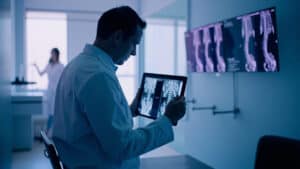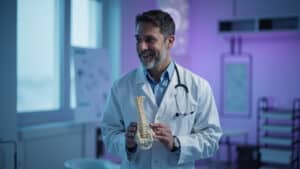Spinal Instability Causes And Treatments: A Physician-Led, Evidence-Based Guide
Written by Dr. Matthias Wiederholz, MD – Quadruple Board Certified in Physical Medicine & Rehabilitation, Pain Medicine, Sports Medicine, and Anti-Aging, Regenerative & Functional Medicine
Quick Insights
Spinal instability causes and treatments refers to the inability of the spine to maintain its normal alignment during movement, leading to pain or neurological symptoms. Early recognition and expert evaluation are crucial to prevent progressive damage and maintain an active lifestyle. Recent research supports advanced, targeted management.
Key Takeaways
- Spinal instability develops when supporting muscles, ligaments, or spinal discs weaken or get damaged.
- A bulging disc can be both a cause and a symptom, impacting stability and movement control.
- Certain non-surgical procedures may offer faster recovery times compared to traditional spinal fusion in specific cases..
- Addressing spinal instability promptly preserves independence, lowers risk of long-term disability, and restores hope for those frustrated by failed treatments.
Why It Matters
For active individuals, spinal instability can threaten cherished activities and independence—leading to persistent discomfort, loss of confidence, and daily limitations. Understanding spinal instability causes and treatments empowers you to seek proactive care, regain control, and avoid the cascade toward more severe, life-changing spine problems. Learn more about Discseel® at Performance Pain and Sports Medicine.
As a quadruple board-certified interventional pain specialist and recognized leader in regenerative spine care, I bring proven expertise in spinal instability causes and treatments.
Spinal instability causes and treatments refer to a condition where your spine cannot maintain normal alignment during everyday movement—often leading to pain, nerve irritation, or trouble staying active. The impact is more than physical; it can erode your confidence, limit favorite activities, and create real anxiety about your long-term independence here in Houston, TX.
Most patients I see are frustrated by back pain or balance issues that haven’t improved with standard care. Recent research reinforces that advanced, minimally invasive solutions now offer better outcomes and faster recovery than conventional surgery, especially for complex problems like a spinal instability bulging disc.
If you want fast answers, real options, and care that truly prioritizes your return to activity, read on—I’ll explain what spinal instability is, why it matters, and how today’s treatments can help you reclaim your life.
What is Spinal Instability?
Spinal instability refers to the inability of the spine to maintain its normal alignment during movement, resulting in pain, nerve irritation, or reduced function. This occurs when the delicate balance among the bones, discs, muscles, and nerves that stabilize your spine is disrupted. Many people are surprised to learn their lingering symptoms aren’t “just a strain” but are rooted in subtle, undiagnosed instability—something I routinely uncover in patients who have been searching for answers.
Key causes include:
- Weak or damaged spinal discs
- Ligament laxity (looseness)
- Muscle weakness or poor coordination
- Repetitive strain or injury
When these crucial systems fail to work together, your spine becomes vulnerable to abnormal motion and progressive structural changes. As a quadruple board-certified specialist in regenerative spine care, I often see that low back and neck instability are common, especially in busy, active individuals. If left untreated, instability can escalate—causing nerve compression, chronic pain, and sometimes permanent limitations. Early recognition and expert intervention are critical to prevent long-term disability and help you stay active. See Understanding S1 Nerve Distribution: Anatomy, Symptoms, and Treatment for a comprehensive overview.
In my practice, I frequently encounter patients who have spent years exploring treatments—from surgeries to pain medications—without meaningful relief. Often, they are unaware that minimally invasive regenerative solutions now exist to restore their spine health. Discover more information about Discseel® at Performance Pain.
Causes of Spinal Instability
Spinal instability develops when the structures that support the spine—bones, discs, ligaments, muscles, and the nerves that coordinate them—are disrupted. As a spine specialist trusted by patients throughout Houston and beyond, I find that these root causes often go overlooked until pain interferes with daily life.
Muscle Weakness and Ligament Laxity
Muscle weakness and ligament laxity are leading contributors to instability. When the core and spinal muscles weaken or ligaments become overstretched, the spine loses its crucial support network. This weakening may result from aging, sedentary lifestyles, previous injuries, or simply a lack of targeted exercise.
Research shows spinal stability relies on three interdependent subsystems:
- The passive system (bones, discs, ligaments)
- The active system (muscles)
- The neural control system (coordinates muscle activation)
When any of these subsystems becomes unbalanced, instability and disc changes can follow. Read about the guide to spinal disc tears and treatment options. Lack of neuromuscular coordination—a disconnect between the brain and spine-stabilizing muscles—is a particularly common driver of disc damage.
As a quadruple board-certified regenerative medicine specialist, I’ve observed that addressing underlying muscle weakness and neuromuscular dysfunction is essential for restoring both spine health and confidence.
Postural Strain and Repetitive Injury
Daily habits and workplace ergonomics can quietly erode spinal stability. Poor posture, frequent heavy lifting, repeated twisting, and even long periods of sitting put uneven strain on your spine and supporting tissues. Over time, repetitive stress may contribute to the weakening of ligaments and damage to spinal discs.
In my Houston clinics, I’ve encountered countless patients who never realized their simple daily movements or exercise routines were fueling chronic instability. Only a detailed evaluation uncovers these subtle patterns, allowing truly targeted recovery strategies. Read about treatments for disc desiccation for more.
Symptoms and Diagnosis
Spinal instability can masquerade as common aches or muscle fatigue, yet its symptoms are often more persistent, confusing, or disabling. Swift, expert diagnosis is key to meaningful recovery.
Common Warning Signs
- Persistent or recurring back or neck pain
- Sudden sensations of “giving way” or spinal catching
- Muscle spasms or cramping
- Difficulty maintaining posture or balance
- Unexplained episodes of weakness or numbness
Chronic muscle pain and spasm are not just side effects—they are hallmark indicators of spinal instability, supported by recent research in clinical neurology. Many of my patients describe deep, aching discomfort or unpredictable “flare-ups” that don’t resolve with rest or standard treatments.
Having personally performed over 10,000 regenerative spine procedures, I’ve consistently witnessed that restoring function and quality of life demands not just technical expertise, but an understanding of each patient’s unique physical and emotional journey.
How Diagnosis Is Made
Diagnosis begins with a comprehensive discussion of your symptoms, activity patterns, and prior treatments, followed by a targeted physical exam. I use advanced imaging—such as MRI or dynamic X-rays—to evaluate disc integrity, spinal alignment, and subtle movements that may escape detection with standard scans.
Specialized motion studies can further clarify hidden instability. Strict adherence to advanced diagnostic protocols, as outlined in clinical guidelines, ensures a thorough and accurate assessment—directing you to the right treatment at the right time. Learn more about disc tear treatment.
When to Seek Medical Attention
If you experience:
- Sudden loss of bladder or bowel control
- Severe or unrelenting pain
- Progressive numbness or weakness in your arms or legs
Seek immediate medical help—these may signal a more serious spinal emergency.
Unlike larger clinics where patients may rarely see the same provider, I personally oversee every step of your diagnosis and recovery, ensuring your concerns are heard and your treatment is precisely matched to your needs. Read about emergency symptoms of a herniated disc.
Bulging Discs and Spinal Instability
A bulging disc (when the soft inner material of a spinal disc pushes outward) frequently occurs as both a cause and a consequence of spinal instability. When your spine moves abnormally—due to weak muscles or stretched ligaments—discs must absorb more stress than nature intended. Over time, this abnormal load can cause discs to bulge, herniate, or even tear.
Disc bulges can compress nearby nerves, triggering pain, numbness, or tingling in the back, legs, or arms. Spinal instability can lead to disc damage, potentially exacerbating the instability.
In my experience, the key to real relief is to address both the structural instability and the damaged disc—rather than simply masking symptoms. Patients who have chased quick fixes or undergone invasive surgeries elsewhere are often relieved to find that precise, minimally invasive, regenerative treatments exist to break this cycle.
Conservative and Traditional Treatments
Most cases of spinal instability can be stabilized without open surgery—especially when addressed early. My treatment philosophy always prioritizes the safest, least invasive options, progressing only as needed.
First-line treatments include:
- Physical therapy and targeted exercise
- Activity modification and ergonomic optimization
- Non-opioid pain management
- Image-guided injections, as appropriate
Physical Therapy and Rehabilitation
Customized physical therapy, focused on core strengthening, balance, and posture, forms the foundation of conservative care. Recent systematic reviews confirm that well-designed physiotherapy can substantially reduce pain and disability in lumbar instability. Explore herniated disc exercises for relief and strengthening. I collaborate closely with rehabilitation specialists, ensuring your program is uniquely suited to your activity goals and lifestyle.
I find that patients regain confidence and stability fastest when therapy is paired with education on posture, daily movement, and at-home exercises tailored to their real-world activities.
When Surgery Is Considered
Surgical intervention—such as spinal fusion, which irreversibly joins vertebrae—is reserved for severe, unresponsive cases. However, growing evidence shows that non-surgical, regenerative approaches frequently match or exceed the long-term effectiveness of surgery, while preserving motion and minimizing risk.
As a national leader in regenerative spine care, I utilize advanced, minimally invasive options whenever possible—helping patients avoid the limitations and recovery time of traditional surgery. Read more about L5-S1 herniated disc surgery overview.
The Discseel® Procedure: A Revolutionary Solution
The Discseel® Procedure is a minimally invasive, non-surgical innovation designed to repair damaged spinal discs and restore stability—without incisions or implants. I am honored to have been trained directly by Dr. Kevin Pauza, inventor of Discseel®, and to serve as a master instructor, sharing this breakthrough with physicians nationwide.
How the Procedure Works
Under gentle sedation and live imaging, a biologic fibrin sealant (made from the proteins responsible for natural healing) is injected directly into weakened or torn spine discs. This sealant acts as a “biologic patch,” sealing leaks and stimulating natural collagen regeneration from within.
Most patients are surprised by the simplicity:
- No large incisions or hardware
- Performed in-office, under local anesthesia
- Walk out the same day; typical downtime is just a few days
As a leader in the Discseel® technique, I’ve successfully treated patients from across Houston and beyond who were previously told invasive fusion was their only answer. Read Discseel® reviews: achieving lasting back pain relief.
Outcomes and Success Rates
Discseel® delivers an 82% success rate for lasting pain relief—far surpassing the roughly 31% average for conventional spinal fusion—while maintaining spinal flexibility and function.
Recent systematic reviews further substantiate that advanced regenerative procedures provide faster recovery, lower complication rates, and improved patient satisfaction compared to traditional surgery.
As a quadruple board-certified provider with over 10,000 minimally invasive procedures performed, I’ve seen firsthand how Discseel® gives renewed hope and mobility to patients who thought they were out of options. The greatest reward is witnessing people reclaim the activities and confidence that pain had taken from them.
Why Choose Dr. Matthias Wiederholz in Houston, TX?
Choosing the right provider can mean the difference between ongoing frustration and a return to living on your terms. As Houston’s only quadruple board-certified regenerative spine specialist and a national master instructor for Discseel®, my mission is clear: deliver advanced, compassionate, and personalized care that empowers you to move freely and confidently again.
- Unlike many large clinics, I personally guide every aspect of your journey—from diagnosis to recovery.
- My offices in Houston and Lawrenceville offer a boutique, concierge experience—ensuring you’re never just a number.
- With direct mentorship from Dr. Kevin Pauza, you gain access to world-class regenerative procedures not available at most academic or hospital centers.
I am deeply committed to holistic, patient-first recovery—combining clinical excellence with genuine listening and guidance on exercise, ergonomics, and ongoing spine wellness. Whether you’re an athlete sidelined by instability or an active parent longing for relief, let’s partner to restore your quality of life. Meet Dr. Matthias Wiederholz, MD.
Patient Experiences
“After years of back pain and two failed surgeries, I finally found Dr. Wiederholz. He listened to my concerns, explained all my options, and performed the Discseel® Procedure. Within weeks, my pain was gone, and I was back to hiking with my family. I only wish I’d found him sooner!”
Discover more real success stories and learn how Houston-area patients have overcome chronic spine issues through compassionate, state-of-the-art care. Explore more on L5-S1 pain and its causes, symptoms, and treatment.
What Our Patients Say on Google
Patient experiences are at the heart of my approach to spinal instability causes and treatments. Every story is a reminder of why I strive for excellence and innovation in spine care.
I recently received feedback that captures what we aim to provide for every patient who walks through our doors:
“I am so happy that I was given a referral to see Dr. Wiederholz, after having this back pain for many years and the injections did not help, Dr Wiederholz, took care of all my problems. I would refer anyone to him, staff are amazing, helpful too. His surgical group are just beyond help, they explained everything to me before I went into surgery. Dr Wiederholz, came in and spoke to me before he did the Mild procedure. I will give him an A++, thank you for a job well done.” — Mary
Read more Google reviews here.
Hearing this kind of appreciation reinforces my commitment to delivering advanced, compassionate care for spinal instability in Houston, TX.
Spinal Instability Causes and Treatments in Houston, TX
Living in Houston, TX, means access to some of the most advanced spine care options in the country, including the latest non-surgical treatments for spinal instability. The city’s active lifestyle and diverse population often bring unique challenges, from sports injuries to work-related strain, making early intervention and expert evaluation especially important.
As a physician practicing in Houston, I see firsthand how our climate, local work environments, and recreational habits can influence the onset and progression of spinal instability. Many patients may benefit from personalized care plans that consider their unique lifestyles and recovery goals.
At Performance Pain and Sports Medicine, we are dedicated to serving the Houston community with evidence-based, minimally invasive solutions like the Discseel® Procedure. If you’re in Houston and struggling with back or neck pain, I invite you to see if you’re a candidate for this breakthrough treatment—so you can get back to enjoying everything our city has to offer.
Conclusion
Spinal Instability Causes and Treatments can disrupt your life, but you don’t have to accept ongoing pain or loss of mobility. My approach focuses on restoring your spine’s stability and function using advanced regenerative care, without invasive surgery. By addressing both the physical and emotional toll of spinal instability, I help patients in Houston, TX, return to the activities they love—often after years of frustration with standard treatments.
As a quadruple board-certified regenerative spine specialist, I offer the Discseel® Procedure and other minimally invasive solutions that deliver real, lasting relief. Research demonstrates that conservative, evidence-based treatments can significantly improve outcomes for those struggling with spinal instability. If you’re ready to stop missing out on life, I invite you to see if you’re a candidate for the Discseel® Procedure.
Take the first step—request a consultation today. Let’s restore your spine and reclaim your life.
This article is for educational purposes only and should not be used as a substitute for professional medical advice, diagnosis, or treatment. Always seek the advice of your physician or other qualified healthcare provider with any questions you may have regarding a medical condition or treatment options. Never disregard professional medical advice or delay in seeking it because of something you have read in this article.
Frequently Asked Questions
What are the main causes and treatments for spinal instability?
Spinal instability is most often caused by weakened muscles, ligament laxity, or disc damage. Treatments range from targeted physical therapy and activity modification to advanced regenerative procedures like the Discseel® Procedure. Many patients experience significant improvement with non-surgical options, especially when instability is identified early. Read more about degenerative disc disease treatment options.
Where can I find advanced spinal instability treatments in Houston, TX?
You can find advanced, minimally invasive treatments for spinal instability at my Houston practice. I offer personalized evaluations and evidence-based procedures, including the Discseel® Procedure, to help patients regain mobility and reduce pain. Prompt, expert care in Houston ensures you don’t have to travel far for world-class spine solutions.
How do you help patients who have tried everything for back pain?
I specialize in helping patients who feel they’ve exhausted all options. My approach combines thorough diagnosis, advanced regenerative treatments, and compassionate, one-on-one care. Even if you’ve had failed surgeries or persistent pain, there are innovative solutions

















